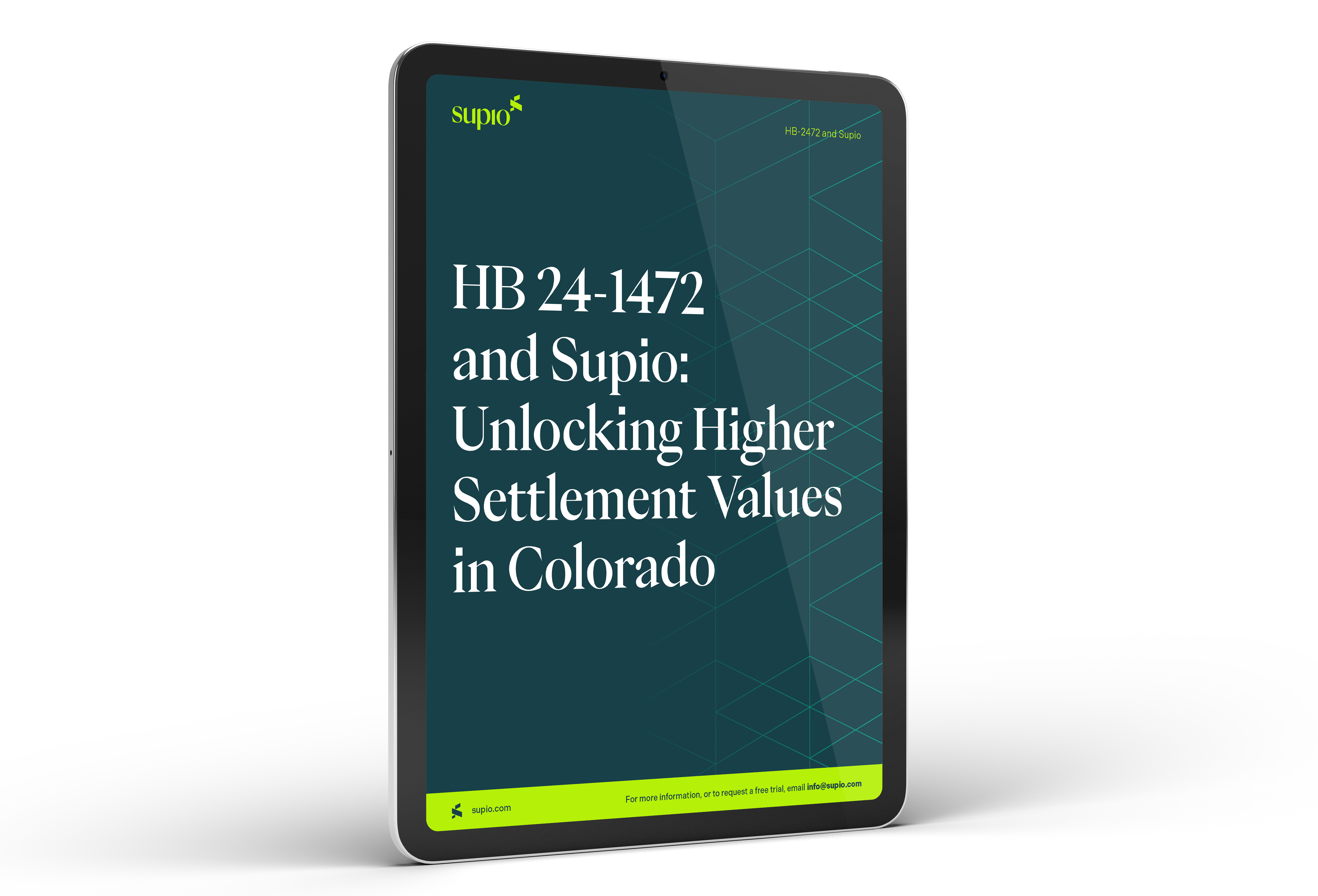
HB 24-1472 and Supio: Unlocking Higher Settlement Values in Colorado
As of January 1, 2025, Colorado’s House Bill 24- 1472 introduced significant changes to tort actions, doubling caps on noneconomic damages and increasing wrongful death claim limits. With the cap on noneconomic damages rising to $1.5 million and wrongful death damages increasing to $2.125 million, the legislation has created a new era for personal injury law. These changes demand enhanced efficiency, accuracy, and strategy from legal professionals.
Supio’s AI-powered tool offer personal injury attorneys the competitive advantage to navigate this new landscape. By automating data analysis, generating precise medical chronologies, and predicting settlement outcomes, Supio helps attorneys deliver more potent case strategies while saving valuable time. Let’s explore the implications of HB 24-1472 and how Supio empowers legal professionals to unlock higher settlement values.
Colorado’s House Bill 24-1472 represents one of the most significant reforms to the state’s tort laws in decades. Key provisions include:
- Increased Noneconomic Damages Cap: The cap for noneconomic damages in tort actions rises from $729,790 to $1.5 million, with inflation adjustments beginning in 2028.
- Higher Wrongful Death Damages Cap: The cap on noneconomic damages for wrongful death actions increases to $2.125 million, tripling the previous limit.
- Incremental Increases in Medical Malpractice Caps: The cap for wrongful death in medical malpractice cases will rise incrementally to $1.575 million by 2029, and the cap for noneconomic damages in medical malpractice injury claims will increase to $875,000 by 2029.
- Inflation Adjustments: Beginning January 1, 2028, all caps will be adjusted biennially for inflation.
The law also eliminates the prior linkage of damage caps to the date of loss. Instead, the new caps apply to all cases filed on or after January 1, 2025, which has created a significant incentive for claimants to delay filings until the new caps took effect. Attorneys have been anticipating a surge in filings in early 2025 and heightened expectations for settlement values.
While promising greater compensation for plaintiffs, these changes present challenges for attorneys regarding case management, documentation accuracy, and strategic planning for attorneys.
The increased damages caps bring new opportunities but also amplify the challenges lawyers face. Key challenges include:
3.1 Managing Larger Case Volumes
With claimants likely to delay filings to benefit from higher caps, attorneys will face a surge in new cases in 2025. Managing the volume of documentation, deadlines, and client interactions will require streamlined processes.
Legal teams must handle the increased caseload efficiently while maintaining accuracy in document preparation, organization, and presentation. Firms that fail to adapt will likely fall behind competitors who leverage advanced tools like AI to manage workflows.
Supio Solution: Supio’s ability to automate document sorting and analysis helps attorneys manage large caseloads without sacrificing accuracy. It also integrates with case management systems to simplify organization and streamline communication between legal teams.
3.2 Higher Settlement Expectations
The higher caps significantly increase the stakes for both claimants and defendants. Attorneys will need to provide comprehensive evidence and clear justifications for larger settlement demands.
As settlement values increase, attorneys must quantify damages comprehensively and present them persuasively. Clients and opposing counsel alike will expect detailed, evidence-based arguments to justify higher compensation levels.
Supio Solution: By automating the creation of medical chronologies and analyzing financial data, Supio equips attorneys to substantiate higher settlement demands with precision. Its intuitive dashboards provide visual representations of case data, making it easier to communicate complex details to stakeholders.
3.3 Greater Scrutiny of Evidence
Given the potential for larger payouts, opposing counsel and courts will scrutinize every piece of evidence more rigorously. Attorneys must ensure precision in analyzing medical records, financial data, and expert testimonies.
The stakes are higher than ever, and even minor discrepancies in evidence could undermine a case. Lawyers will need tools to quickly identify inconsistencies and make sure all documentation is airtight.
Supio Solution: Supio’s AI-driven tools quickly identify inconsistencies or gaps in evidence, enabling attorneys to address them proactively. Its advanced search capabilities allow pinpointing critical details within thousands of documents, saving valuable time.
3.4 Tight Timeframes
Delays in filings and increased caseloads will pressure legal teams to process cases quickly while maintaining accuracy and strategic depth.
Efficient case preparation will become a competitive differentiator in this high-stakes environment. Attorneys must balance speed with thoroughness to meet tight deadlines without compromising the quality of their work.
Supio Solution: By streamlining document review and automating repetitive tasks, Supio allows attorneys to focus on strategy and advocacy within compressed timelines. The platform’s real-time updates help teams stay on track with deadlines.
3.5 Adapting to Inflation Adjustments
With damages caps set to adjust biennially for inflation starting in 2028, attorneys will need tools to project settlement values accurately over time and adapt strategies accordingly.
Inflation adjustments add a layer of complexity to case valuation. Attorneys must account for these future changes when advising clients or negotiating settlements.
Supio Solution: Supio’s predictive analytics can project future settlement amounts by incorporating inflation trends, ensuring attorneys remain ahead of these adjustments. Its flexible modeling tools help simulate various scenarios to optimize case strategies.
Supio’s AI-powered platform is purpose-built to address the challenges HB 24-1472 created. Here’s how Supio enables attorneys to excel:
4.1 Automating Document Analysis
Supio’s advanced document analysis capabilities allow legal professionals to extract key insights from thousands of pages of medical records, depositions, and financial documents in minutes. By automating this process, Supio ensures no critical detail is overlooked.
Automated document analysis also reduces the risk of human error, so that every piece of evidence is accurately categorized and prioritized. This capability is essential for handling the increased documentation resulting from higher damages caps.
Example: An attorney preparing a wrongful death case uses Supio to identify gaps in medical treatment timelines, which could justify a higher settlement demand.
4.2 Generating Medical Chronologies
Medical records are often the cornerstone of personal injury cases. Supio automates the creation of accurate, detailed medical chronologies that highlight diagnoses, treatments, and outcomes. These chronologies are linked directly to the source documents, guaranteeing transparency and credibility.
Supio’s automated chronologies save lawyers and paralegals countless hours, enabling them to focus on building stronger arguments and negotiating better settlements.
Example: Supio’s chronology feature helps an attorney present a compelling timeline of a client’s suffering and recovery, supporting a $1.5 million noneconomic damage claim.
4.3 Predictive Analytics for Settlement Strategies
Supio’s predictive analytics tools analyze historical case data to forecast settlement values, trial outcomes, and success probabilities. This insight empowers attorneys to refine negotiation strategies and set realistic client expectations.
Predictive analytics also give lawyers a competitive edge by highlighting patterns and trends in similar cases. This information helps refine litigation strategies and ensures optimal resource allocation.
Example: An attorney uses Supio to predict the likely settlement range for a case involving noneconomic damages and adjusts their approach accordingly to secure maximum compensation.
4.4 Automating Legal Document Drafting
From demand letters to complaints, Supio’s AI can draft key legal documents in minutes, consistently and accurately. Attorneys can customize templates to reflect specific case details and client needs.
By automating document drafting, Supio enables lawyers to handle more cases simultaneously while maintaining high standards of quality and consistency.
Example: An attorney drafts a demand letter for a $2.125 million wrongful death claim, relying on Supio to thoroughly document all damages.
4.5 Financial Calculations and Damage Analysis
Supio simplifies financial calculations, aggregating medical expenses, lost wages, and other economic damages. This ensures accurate, comprehensive settlement demands that withstand scrutiny from opposing counsel.
Accurate financial calculations are critical for substantiating claims under the higher caps introduced by HB 24-1472. Supio’s tools confirm that every dollar is accounted for and justified.
Example: Supio calculates the total damages for a case, ensuring the $1.5 million noneconomic damages cap is fully leveraged.
4.6 AI-Powered Case Insights
Supio identifies patterns in case data, uncovering weaknesses or opportunities that might go unnoticed. These insights allow attorneys to craft stronger strategies.
By uncovering hidden details, Supio helps legal teams anticipate opposing counsel’s arguments and proactively address potential challenges.
Example: An attorney uses Supio to identify inconsistencies in opposing counsel’s expert reports, strengthening their argument during negotiations.
Supio offers several advantages to personal injury attorneys navigating the new legal landscape:
- Efficiency: Automate time-consuming tasks like document review and chronology creation, enabling legal teams to handle more cases with fewer resources.
- Accuracy: Reduce human error with AI-powered insights and calculations, for stronger, more defensible claims.
- Scalability: Manage increased case volumes without compromising quality or timelines.
- Strategic Insights: Use predictive analytics to anticipate settlement values and refine negotiation strategies.
- Transparency: Build client trust with clear, databacked justifications for settlement demands.
- Future-Proofing: Stay ahead of inflation adjustments and legislative changes with adaptable AI tools.
In addition, Supio’s intuitive interface and robust support make it accessible for firms of all sizes, from solo practitioners to large-scale operations. This flexibility means that every attorney can leverage the platform to improve client outcomes.
6.1 AI Adoption in the Legal Profession
The legal industry is rapidly embracing AI as a necessity rather than a luxury. According to the Clio Legal Trends Report for 2024, AI adoption among legal professionals increased from 19% in 2023 to 79% in 2024. Similarly, 92% of legal professionals plan to expand their use of AI tools for analytics in the next year.
Why This Matters for Colorado Attorneys: With higher stakes and increased caseloads under HB 24-1472, AI tools like Supio are essential for staying competitive and meeting client expectations.
6.2 Financial Impacts of AI
The Future of Professionals Report estimates that AI could save attorneys up to four hours per week, translating to $100,000 in additional billable time annually for U.S. lawyers. This efficiency gain is particularly valuable in the context of higher damages caps, where attorneys must balance speed with precision.
6.3 Competitive Edge
With 53% of AmLaw 200 firms already using generative AI tools, smaller firms must adopt AI to compete effectively. Supio offers scalable solutions that empower firms of all sizes to thrive in the evolving legal landscape
The impact of HB 24-1472 extends beyond individual cases, influencing the legal industry, insurance markets, and client expectations:
- Insurance Considerations: The increased caps may drive higher premiums and force insurance companies to reassess coverage limits.
- Client Expectations: As settlement amounts rise, clients will demand more transparency and precision, placing greater pressure on attorneys to deliver high-quality representation.
- Economic Impacts: The legislation’s inflation adjustments ensure that settlement values remain competitive over time, reinforcing the need for scalable legal tools like Supio.
- Enhanced Client Relationships: By leveraging AI tools like Supio, attorneys can provide frequent updates and insights to clients, fostering trust and satisfaction in high-stakes cases.
- Legislative Impact: This law sets a precedent for how other states might approach reforming damage caps, making Colorado a leader in adapting legal frameworks to modern economic realities.
Colorado’s HB 24-1472 marks a transformative moment for personal injury law. It creates opportunities for higher settlements while demanding greater precision and efficiency from legal professionals. Supio is uniquely positioned to help attorneys navigate this new reality, offering tools that streamline workflows, enhance accuracy, and deliver actionable insights.
By automating key processes, generating data-driven chronologies, and providing predictive analytics, Supio empowers attorneys to unlock the full potential of HB 24-1472. Whether preparing demand letters, calculating damages, or forecasting case outcomes, Supio helps attorneys deliver exceptional client results.
Ready to elevate your practice and maximize settlement values? Schedule a demo today and discover how Supio can transform your approach to personal injury law.



